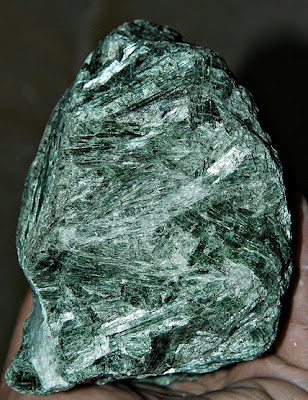The term "asbestos" refers to six fibrous minerals that have been commercially exploited and occur naturally in the environment. The U.S. Bureau of Mines has named more than 100 mineral fibers as "asbestos-like" fibers, yet only six are recognized regulated by the U.S. government. This is largely due to influential lobbying by the asbestos and stone industries, which powerfully shaped how the public perceives asbestiform minerals.
The six asbestiform minerals recognized by the government include, tremolite asbestos, actinolite asbestos, anthophyllite asbestos, chrysotile asbestos, amosite asbestos, and crocidolite asbestos. Each of these minerals is categorized into two groups, serpentine and amphibole. Chrysotile asbestos is the only member of the serpentine group and the others belong to the amphibole group. The difference between these two groups is characterized by the physical components of the asbestos fibers. The serpentine group is made up of minerals that have a layered form and curly fibers and the latter group contains minerals that have straight fibers with a chain-like structure.
In order to fully understand the importance and function of these minerals, it is necessary to examine each mineral in more detail.
Chrysotile Asbestos
Chrysotile asbestos is better known as white asbestos and is made up of fine, silky, flexible white fibers. Chrysotile consists of minerals crystallized in a serpentine pattern, which means its crystals are formed in sheets. This is the most common type of asbestos comprising approximately 95 percent of all asbestos commercially used in the United States. Due to the widespread use of this fiber, chrysotile accounts for the majority of asbestos-related health problems throughout the world.
Chrysotile, as well as other forms of asbestos, is considered to be a human carcinogen by the International Agency for Research on Cancer (IARC) and by the U.S. Department of Health and Human Services. Asbestos exposure is associated with parenchymal asbestosis, asbestos-related pleural abnormalities, mesothelioma, and lung cancer, and it may be associated with cancer at some extra-thoracic sites.
Tremolite Asbestos

Tremolite is a relatively common mineral found in most metamorphic rocks. Its color ranges from a creamy white to dark green. Tremolite asbestos has been used for industrial purposes (though not as much as chrysotile) and has been identified as an ingredient in some household products, primarily talcum powder (which is also a known carcinogen). This form of asbestos is the major asbestiform contaminant of the infamous vermiculite mine in Libby, Montana.
The Mineral Tremolite:
* Chemistry: Ca2Mg5Si8O22(OH)2 , Calcium Magnesium Silicate Hydroxide.
* Class: Silicates
* Subclass: Inosilicates
* Group: Amphibole
* Uses: Asbestos and as a mineral specimen.
Tremolite is a relatively common mineral in some metamorphic rocks. It occurs from the conversion of dolomite, silica and water into tremolite, calcite and carbon dioxide
A fibrous variety of tremolite is used as asbestos. This material is toxic and inhaling the fibers can lead to asbestosis, lung cancer and mesothelioma.
Actinolite Asbestos

Actinolite asbestos is a relatively common mineral existing in metamorphic rocks. This type of asbestos is usually green, white, or gray and it is closely related to the aforementioned tremolite mineral (actinolite contains a greater presence of iron over magnesium than tremolite).
Actinolite is composed of the elements calcium, magnesium, iron, silicon, oxygen, and hydrogen.
Scientists and medical professionals have confirmed that actinolite and other forms of asbestos are human carcinogens. Exposure to these minerals can lead to the development of asbestos-related cancers, such as lung cancer and mesothelioma cancer.
In addition to these sources of actinolite asbestos, evidence indicates that actinolite may be found in children's toys, drywall compounds, joint compounds, and a number of other products. Considering the evidence, thousands of people may have been unknowingly exposed to actinolite asbestos through products or environmental conditions. No matter the source, whether it's a pipe sealant in the home or an environmental contamination in a community, actinolite is extremely harmful to human health.
Anthophyllite Asbestos

Anthophyllite asbestos is commonly identified by its brittle white fibers that are made of crystals and have a chain-like appearance. This type of asbestos is formed by the breakdown of talc in ultramafic rock, and as such, anthophyllite is a common contaminant of talc. Anthophylite is the product of metamorphism of magnesium-rich rocks especially ultrabasic igneous rocks and impure dolomitic shales.
The Mineral ANTHOPHYLLITE:
* Chemistry: (Mg, Fe)7Si8O22(OH)2 , Magnesium Iron Silicate Hydroxide.
* Class: Silicates
* Subclass: Inosilicates
* Group: Amphibole
* Uses: Are limited to some asbestos uses and as mineral specimens.
Like other forms of asbestos, anthophyllite poses a serious health threat. Several decades ago, health authorities and scientists confirmed anthophyllite is a human carcinogen. When people come into contact with anthophyllite asbestos and inhale or ingest its fibers, the fibers have the potential to become lodged in the mesothelial lining of the lungs, heart, abdomen, or testicles. The fibers can eventually lead to the development of lung cancer, mesothelioma cancer, and other life-threatening cancers and illnesses.
In addition to being intentionally used in a number of popular consumer products, anthophyllite has also been a common contaminant in talc, the mineral from which this deadly material is derived. According to studies, anthophyllite is formed when high temperatures are sustained, which destabilizes the talc mineral and causes it to disintegrate. The geologic link between these two minerals serves as an explanation of the occasional (less common today than three decades ago) contamination of talc with anthophyllite asbestos, which has been observed in scientific studies of talc at a weight as low as 2 percent of the total mineral weight. Because talcum powders and other products made from talc may contain anthophyllite asbestos, thousands of consumers - including countless infants and children - may have been exposed to anthophyllite, which is known to cause serious illnesses such as asbestosis, lung cancer, and mesothelioma.
Individuals living various lifestyles and working in a slew of occupations may have been exposed, from painters to construction workers to shipyard workers, just to name a few. Those who have worked with or otherwise used asbestos-containing products such as those described above may have been exposed to anthophyllite asbestos. Additionally, those who believe they may be at risk for developing an asbestos-related illness should contact an experienced mesothelioma lawyer. A mesothelioma lawyer can help answer any questions about anthophyllite and other forms of asbestos, as well as offer information on the legal options available to victims of asbestos exposure.
Amosite Asbestos

Amosite asbestos is an amphibole.
Amosite asbestos is identified by its straight, brittle fibers that are light gray to brown in color. Amosite is also referred to as brown asbestos and its name is derived from the asbestos mines located in South Africa.
The amosite variety of asbestos was used primarily as a fire retardant in thermal insulation products, like ceiling tiles, roof tiles, floor tiles, plumbing insulation, insulation board, chemical insulation, gaskets, lagging, cement sheet, electrical and telecommunication insulation.
Brown asbestos is now banned in most countries and has been for a number of years, but it can still be found in older products and structures, therefore still posing potential dangers, especially because this form of asbestos is highly friable. That means it crumbles easily when damaged, therefore releasing airborne fibers which can then be inhaled by those in the vicinity of the material.
As a form of asbestos, amosite has caused many cases of cancer (including mesothelioma) in people of many countries, but especially near the amosite mines in South Africa, the world's main commercial source of amosite. The workers who mined and processed amosite have cancer rates far worse than those of the general population.
The fibers of amosite are long and thin, and they can be broken into smaller, needle-like pieces. Fragments of amosite fibers are sometimes identified in building materials. As with other types of asbestos (there are six types in all), amosite is less of a danger when it is "trapped" in place in a product. It is when the amosite is being installed, removed or manipulated — or when its fibers are released into the air because of deterioration or damage — that the human beings in the area are vulnerable to asbestos inhalation.
Crocidolite Asbestos

Crocidolite asbestos, better known as blue asbestos, because of its color that ranges from pale green to indigo to Prussian blue. Crocidolite is harder than the other varieties of amphibole asbestos. This form is believed to be the most lethal form of asbestos. Crocidolite asbestos occurs naturally in locations such as Australia, South Africa, Bolivia, the former Soviet Union, and Canada.
Crocidolite asbestos is a form of asbestos known to cause mesothelioma. The fibers of crocidolite — or any other type of asbestos — can become lodged in the lungs or at other internal sites of the body, where they may initiate a process that culminates in asbestos diseases such as asbestosis, mesothelioma and lung cancer.
Some investigators have claimed that crocidolite is the cause of the great majority of mesotheliomas in the world, including most cases from the United States. Since crocidolite was rarely used in shipyards and in insulation products in this country (the source of a large proportion of mesotheliomas in the U.S.), we investigated our files for the proportion of the various asbestos fiber types found in the lungs of patients with mesothelioma. The data summarized below include analyses from more than 1500 fibers from 94 patients with mesothelioma.
MESOTHELIOMA AND FIBER TYPE
Studies of the mineral fiber content of lung in U.S. patients with mesothelioma have shown that amosite is the most common fiber type, accounting for nearly 60% of all fibers 5 or greater in length among more than 1500 fibers analyzed from 94 cases. Ten percent of the fibers analyzed were tremolite, and 3% were chrysotile. (Chrysotile tends to break down in the lungs over time so that there is a relative enrichment of the more stable tremolite contaminant). Crocidolite accounted for only 3% of fibers. Studies have shown that fibers in this size range are capable of reaching the visceral and parietal pleura.
The last five amphibole (which translates to "ambiguous" in Greek) types have a slightly more complex crystal structure than chrysotile and are not used as extensively in commercial products as chrysotile. Due to their structure, amphiboles tend to stay in the lungs longer than chrysotile and are more likely to cause illness because of this factor. Some hypothesize very small contaminations of amphibole fibers within chrysotile are most to blame for cancer deaths caused by asbestos exposure.
Asbestiform minerals are found in serpentine and ultramafic rock. These rocks are located throughout the United States, especially near mountainous regions. California is exceptionally bountiful in asbestos, where the mineral can be found in at least 44 of the state's 58 counties (some geologists report asbestos is found in 50 of the 58 counties). Asbestos fibers especially form near fault zones, where temperature, pressure, and time have transformed the molecules into the asbestiform crystals.
Why is Asbestos Used?
The mineral's innate resistance to heat and fire is what has made asbestos so valuable in both industrial and domestic products. Another valuable feature is its reluctance to conduct electricity. The fibers are fine, flexible and can be spun into thread and woven into cloth that is flameproof, difficult to tear, and carries excellent insulation properties. It is virtually indestructible by heat, salt water, corrosive chemicals (especially alkalies), and any chemical or biological process. The fibers mix well into other materials, such as asphalt or cement, and make such products stronger, more flexible, and fire-retardant. They do not dissolve or evaporate with water, which makes the light fibers easy to mix.
resource : Asbestos.com






1 comment:
Thanks for that great explanation of asbestos exposure causing mesothelioma.
Post a Comment